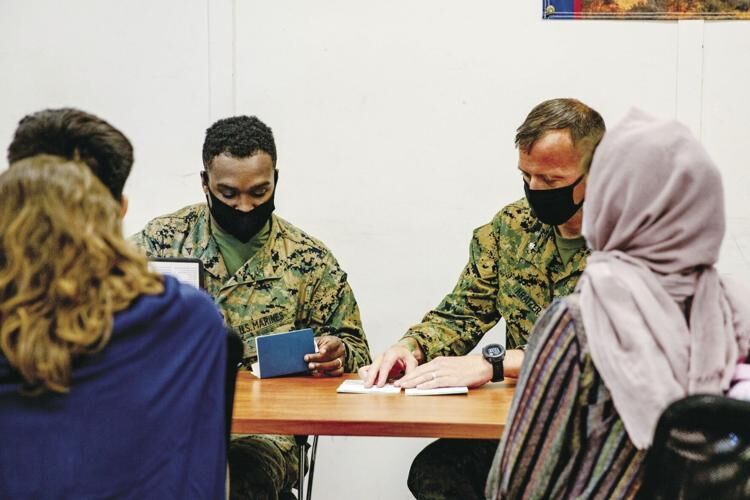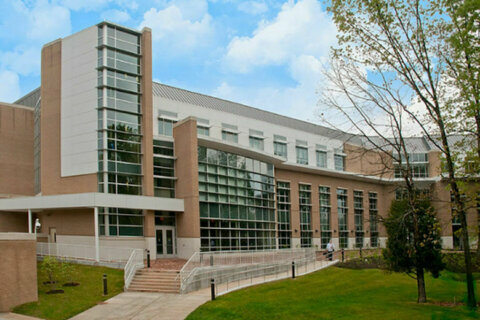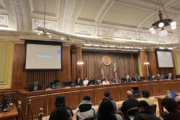
This article was republished with permission from WTOP’s news partner InsideNoVa.com. Sign up for InsideNoVa.com’s free email subscription today.
This article was written by WTOP’s news partner InsideNoVa.com and republished with permission. Sign up for InsideNoVa.com’s free email subscription today.
The now-completed effort to house Afghan evacuees on Marine Corps Base Quantico cost the government more than $188.4 million, according to a report from the Inspector General’s office.
Richard Vasquez, assistant inspector general for audit readiness and global operations, said costs included $182.7 million for a base operations and support services contract, $4.6 million for travel expenses, and $1.1 million for supplies.
The biggest burden of operation fell on the 2nd Marine Logistics Group, of Camp Lejeune, N.C, which was rushed to Quantico to join the U.S. Army Northern Command, Department of Homeland Security, and nongovernmental organizations to become Task Force Quantico and create a sustainable village within days.
Nearly 5,000 Afghans, evacuated after the Taliban took control of the country in the summer, were housed temporarily on the northwestern part of the base, near Nokesville.
Col. Michael Brooks, Quantico commander, recounted the abrupt activity during a Prince William Chamber of Commerce lunch in October.
Around Aug. 23, “I was told to call in to a meeting, but the whole conversation was about Camp Lejeune receiving Afghan guests,” Brooks remembered. “That afternoon, I get an email that ‘Quantico was selected’ and I asked ‘selected for what?’ ‘You got the Afghan mission.’”
Brooks recalls that the next three weeks was a wild ride for everyone involved.
“It just goes to prove that once the United States and DoD make up their mind that they’re going to do something, we’re going to do it,” Brooks said. “I was extremely happy to be a part of that.”
In all, three distinct encampments were capable of housing as many as 5,000 evacuees. For the first two encampments, notes the audit, personnel used the grounds of Camp Upshur, which was an officer candidate school in the 1980s. The area was divided into two encampments: East and West.
Four days after notification, Quantico personnel were able to house the first 1,000 evacuees at Upshur East, using 20 freestanding structures that the Marine Logistics Group had converted into temperature-controlled living quarters. By Sept. 25, one month after receiving the mission, personnel were housing more than 3,755 Afghans.
The third encampment, named Pioneer City, consisted of 80 Marine Corps general purpose tents and was capable of housing 1,000 people. Each tent had air conditioners and heaters. Personnel told inspectors that sustainment of the encampments was a constant effort. Pioneer City was used for single males, single females and families.
Each of the three encampments had a worship tent, and local religious leaders visited Afghan evacuees weekly.
The audit noted that Quantico Civil Affairs personnel hosted Afghan-led classes open to all refugees. These included English classes, as well as classes for culture, hygiene and women’s health. The team also provided recreational opportunities, including movie nights, dance nights and soccer and volleyball tournaments.
Challenges and shortcomings
Medical personnel on Quantico told auditors they faced initial challenges getting the appropriate specialists to support the Afghans. The initial deployment included two medical specialists, general surgeons and anesthesiologists, but task force leaders quickly realized they needed more primary-care specialists, such as pediatricians, dentists and obstetricians and gynecologists, as there were more than 150 pregnant Afghan women.
One of the shortcomings revealed in the audit was that Quantico personnel were not providing all the required age-appropriate immunizations. While the Department of Homeland Security expected evacuees to receive 13 immunizations required by the Centers for Disease Control and Prevention for immigration, the initial group received just four. This shortcoming was remedied with additional vaccinations, and by Oct. 28 more than 99% of the catch-up vaccinations had been administered.
Another issue noted by auditors was not adhering to COVID-19 safety measures.
“During our walkthroughs of the encampments, the audit team observed Afghan evacuees wore face masks while in the medical clinic area, but not at other locations on the encampment. In addition, the audit team observed military personnel not wearing face masks, including individuals indoors and individuals interacting with Afghan evacuees,” the report noted.
The U.S. Army had stipulated that personnel use COVID-19 rapid antigen testing to test evacuees every 72 hours. This proved unrealistic, according to Quantico personnel, as they would have had to test more than 1,000 Afghans each day, and did not have enough test kits to do that. Instead, the clinic tested for COVID-19 only if evacuees were symptomatic or had a known exposure.
After initially documenting the names of evacuees upon arrival, auditors noted, there were no additional accountability checks. The task force relied on Afghan leaders and interagency partners to inform command when individuals went missing or did not show up for scheduled appointments.
At Fort Lee, near Petersburg, south of Richmond, evacuees were issued identifying badges and were required to wear them when moving around the camp. The report noted that, “Without proper accountability of personnel, it was difficult for [task force] Quantico personnel to determine if any Afghan evacuees were missing during an emergency, or other unexpected events,” although the report does not mention any emergencies or missing evacuees.
Effects on readiness, supplies
The Inspector General noted that 2nd Marine Logistics Group provided the majority of staffing, which disrupted its normal operations and could impede future missions. Some of the Marines were removed from training in California that had already been canceled twice due to the pandemic. In addition, the large number of medical personnel required created a burden on Quantico’s overall medical and dental readiness.
Additionally, more than 80 general purpose tents, air conditioning and heating units, generators, and other supplies from Marine Corps units at Camp Lejeune were used to build Camp Upshur East and Pioneer City. Task force personnel said that due to the conditions and length of use of the tents, they will probably be destroyed.
On Dec. 22, the last Afghan evacuees left Quantico.







